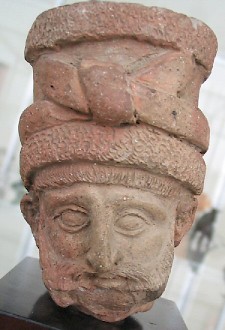Hydarnes (1)
Hydarnes (Old Persian Vidarna): Persian nobleman, one of the seven conspirators who killed the Magian usurper Gaumâta, helped Darius I the Great become king of the Achaemenid empire and was rewarded with the satrapy of Media.

In March 522, a Magian named Gaumâta seized power in the Achaemenid empire, claiming to be the brother of the legitimate king Cambyses, Smerdis. Gaumâta could do this, because Smerdis had been killed in secret. Immediately, Cambyses advanced to the usurper, but he died before he reached Persia; the false Smerdis was able to rule for several months. However, Cambyses' relative Darius, together with six Persian noblemen, killed the usurper (29 September). One of these six men was Hydarnes, the son of Bagâbigna.
Darius became king of an empire in great turmoil. Nearly all provinces of the Achaemenid empire revolted. The most important rebellion was that of the Medes, whose leader was king Phraortes. His rebellion spread to the east to Parthia and to the north to Armenia.
During the winter of 522-521, Hydarnes was in charge of the war against the Medes. As we will see, he was able to occupy the passes between Media and the Persian heartland, between the territories occupied by Phraortes and Vahyazdâta, a rebel who controlled Persia.
A possible explanation is that he had had already been sent to the south from Media, in October. If this is correct, Darius must have sensed immediately after his accession that men like Vahyazdâta would cause troubles in the Persian heartland, and had already sent Hydarnes to control the region. The latter had almost reached Persia when he hard that Media had revolted, and decided to stay where he was, in the mountain area, where he could prevent the two rebels from making contact.
This was very difficult, but he defeated the army of Phraortes near Maruš (Mehriz, thirty kilometers south of modern Yazd) on 12 January. We can read about it in the Behistun inscription:
When he had come to Media, at a city in Media called Maruš, he gave battle to the Medes. He who was chief among the Medes was not there at that time. Ahuramazda brought me help: by the grace of Ahuramazda my army utterly defeated that rebel host. On the twenty-seventh day of the month Anâmaka the battle was fought by them.
Then did my army await me in a district in Media called Kampanda, until I came into Media.
Even though the Medes counted 3,827 (or 5,287) dead and had to see how 4,329 men were taken prisoner by Hydarnes' men, the Persian victory was not as complete as Darius' words ('my army utterly defeated that rebel') suggest. His stay at Kampanda -which is sixty kilometers southwest of modern Yazd near Kermânshâhân- means that he was unable to pursue the enemy and that he had to be content with the defense of the Persian heartland. After four months, king Darius came to Media with a second, newly recruited army, and he made quick work of the rebellion.
It is unclear what became of Hydarnes, but he is probably the same as the Miturna who was satrap of Media in 499. This makes it impossible to identify Hydarnes with the Hydarnes who is mentioned as general in Thrace.note
Hydarnes had at least two sons, Hydarnes and Sisamnes. During king Xerxes' expedition to Greece (480 BCE), the first one commanded the Persian elite corps (which is sometimes called Immortals), and the second the Arians. The family remained influential until Hydarnes' great-grandson Tissaphernes fell in disfavor (395).